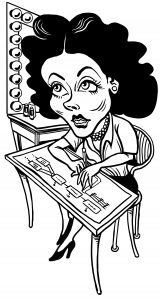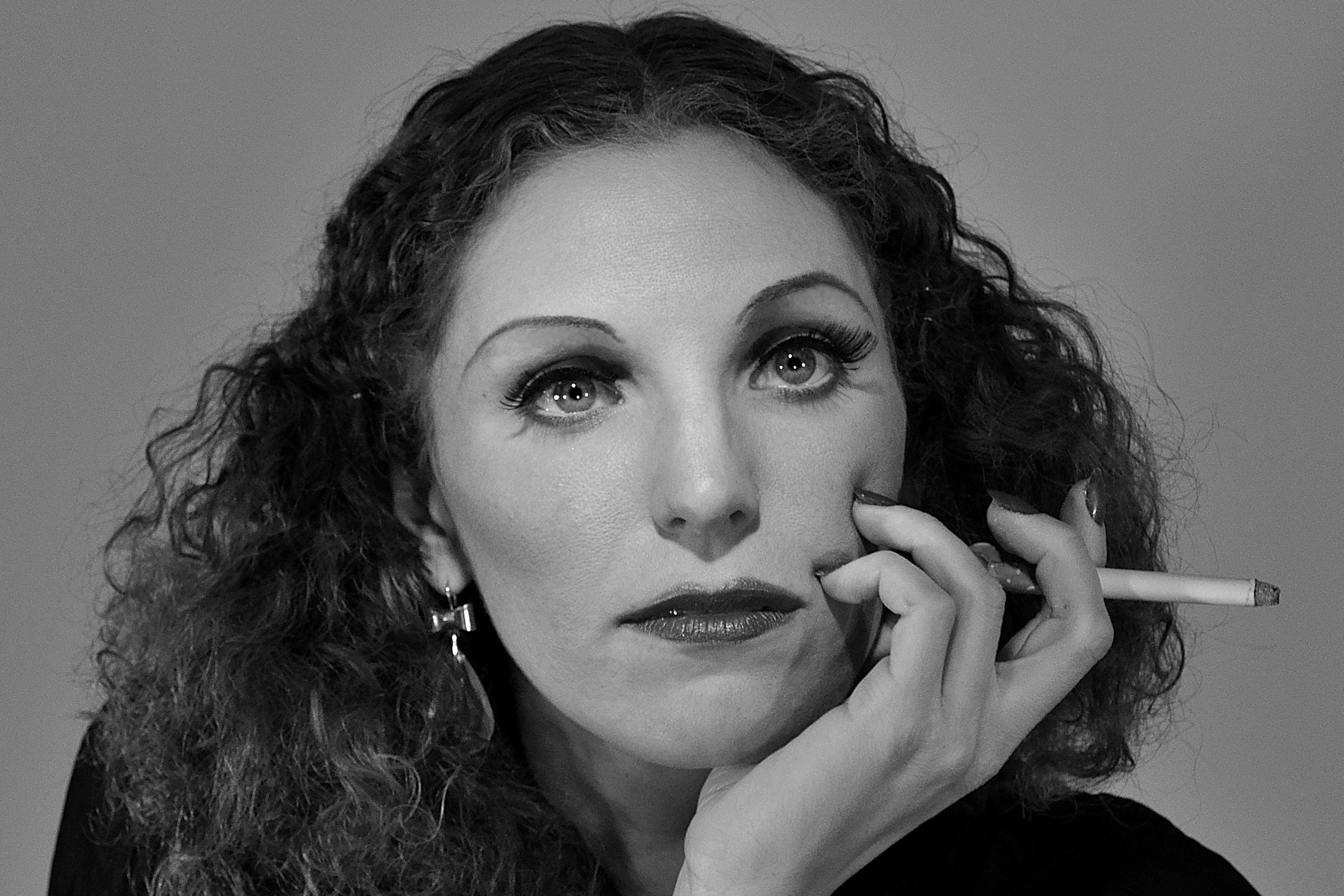 Portrayed by Judith Kalaora
Portrayed by Judith Kalaora
Who would have believed that “The Most Beautiful Woman in the World,” Hollywood star Hedy Lamarr, was a genuine ceiling-crasher scientist whose groundbreaking invention revolutionized modern communication, and made your cell phone, GPS, and Wi-Fi possible? But there’s no law that says an inventor can’t be beautiful.
She was the scintillating adolescent in Ekstase; the cunning wife who wrenched herself free from a dead marriage to a Nazi munitions mogul, the beautiful refugee who fled the Nazis to become a Hollywood movie siren, the Mark Zuckerburg-esque twenty-something brash enough to believe her inventions would upend the world. Perhaps the most important thing Hedy Lamarr reinvented was herself.
For all the girls, women, and anyone ever told they cannot do math, understand science, or change the universe, Hedy Lamarr will inspire you to continue your pursuit to reinvent your world.
Shows Schedule

Judith Kalaora is a professional educator, actress, and living historian. She graduated Magna cum Laude from Syracuse University and holds a Bachelor of Fine Arts in Acting, along with a Bachelor of Arts in Spanish Language and Culture. She attended the Globe Education Program of Shakespeare’s Globe Theatre in London, England.
Judith founded History at Play™ in 2010 to provide educational entertainment, chronicling the lives of influential and often forgotten women. Judith researches, writes, produces and performs.
She also performs as Christa McAuliffe, Dolley Madison, Lucy Stone, Rachel Revere. Last winter she performed in Spartanburg as Deborah Sampson.
For more information: judithkalaora.com
Hedy Lamarr by Judith Kalaora
Upon hearing the name Hedy Lamarr, whom do you see? A smoldering, bejeweled temptress, perched on velour cushions, in the 1949 Hollywood classic Samson and Delilah? Or, a demure and professionally clad inventor, embarking on scientific ideas that were generations ahead of her time? Hedy Lamarr was not only a starlet in Hollywood’s Golden Age; she was also devoted to helping the Allies beat the Nazi forces in WWII. Whether selling war bonds for $50,000 a kiss, or inventing a secret communication system, with the help of American composer George Antheil, Hedy Lamarr knew she was more than just a glamorous girl and was dedicated to reinvigorating American military technology to defeat the Nazis.
Hedy Lamarr, was a Hollywood film star headlining movies with film stars like Clark Gable and Judy Garland during the Golden Age of Hollywood. Born Hedwig Eva Maria Kiesler on November 9, 1914, she was the only child of a well-bred Viennese family who resided in an upscale neighborhood known as The Cottages. Certain she wanted to become a motion picture star, Lamarr dropped out of school at the age of 16 and began performing in both theatre and film. She got her big break in 1933, when a Czechoslovakian art film called Ecstasy(Ekstase) featured Hedy in the title role, as a young girl running away from a loveless marriage.
The film, scandalous at the time, would have been considered feminist had it been made in the 1960s, but in the 1930s, it was an outrage. The film featured Lamarr completely nude. Needless to say, “scandalous” only scratched the surface of the feedback received and Lamarr would be running away from this film for the rest of her life. In spite of launching her to European stardom, the film had tarnished her reputation and set a standard for her as a beautiful woman, a femme fatale, and a dangerous foreigner, but she was never understood for who she really was, which was a precocious and often eccentric genius.
At the age of 19, she married the third richest man in Austria, an arms and munitions dealer named Fritz Mandl; ,President of Hirtenberger-Patronen Frabrik, which supplied weapons to Hitler and Mussolini. She hosted Mussolini, the Nazis, and members of the Austrian Home Guard at their palatial townhouse Schloss Schwarzenau.
By 1937, Hedy had divorced Fritz Mandl and escaped Austria fearing the outbreak of World War II. She negotiated a contract with MGM mogul Louis B. Mayer while onboard the French ship Normandie and arrived in America as “Hedy Lamarr.” Algiers, Hedy’s first American motion picture debuted in 1938, after Louis B. Mayer agreed to loan her out to the United Artists Agency. Hedy’s fate as a Hollywood Starlet was now secure.
In 1941 Hedy Lamarr and musical composer George Antheil collaborated to create a “Secret Communication System.” This invention, based on Hedy’s concept of “frequency hopping” would become the basis of all secure wireless communication, providing the foundation for Spread Spectrum Technology.
On August 11, 1942, the United States Inventors Council, a branch of the United States Navy, awarded Hedy Lamarr and George Antheil Patent # 2,292,387 for their Secret Communication System.
In 1962, three years after the expiration of Hedy and George’s patent, their Secret Communication System was outfitted onto U.S. Naval Vessels and was implemented into active service during the Cuban Missile Crisis, permitting every U.S. Naval Warship blockading Cuba to communicate securely.
Lamarr was a woman who saw boundless opportunity and limitless goals. She was always hungry; hungry for life, hungry for love, hungry for respect and hungry to understand her own identity. The reason why so few people, both American and Austrian, know Lamarr is because she had a difficult time knowing herself. Amongst her closest friends, there are reports that are so conflicting, one might question if they were actually friends with the same person. To one friend, Hedy claimed that she loved to cook. To another, she claimed, she could not bear to be in the kitchen.
Lamarr, known by Americans as “The Most Beautiful Woman in the World” was neither successful at having Americans understand the depth of her genius, nor was she successful in having Europeans understand it either. Her concept of “frequency hopping,” a system that she submitted for patent with the United States Navy during World War II was so ahead of its time and so profound that not even the United States military could figure out what to do with it at that time.
Yet, as soon as technology was digitized, “frequency hopping” could be harnessed in ways never thought possible. Not only was it utilized for Lamarr’s perceived goal to help create a more accurate and effective torpedo system, but also to construct wireless communications as we know them today, via Spread Spectrum Technology. It is for this invention that Lamarr’s birthday, November 9, is considered Inventors’ Day in Europe, yet she is still relatively unknown in her native country of Austria.
Imagine being torn between two worlds: You are a European, but you are an American. You are born a Jew, but you are a converted Catholic. You are a Hollywood Star, but you are a technological maestro. You are beautiful and brilliant. You want people to know your mind, but you are afraid they may not be attracted to your body. No wonder Lamarr did not fully understand herself, just as many beautiful and brilliant women continue to struggle with their identities today. Should you conform to society’s expectations? Or should you be true to yourself?
1914 (November 9) – Born Hedwig Eva Maria Kiesler in Vienna, Austria.
1930 (age 16) – Submits a forged absence request form to her all-girls finishing school in Switzerland and takes a job as a script girl at Sacha Film in Vienna. Drops out of school days later to begin her film career.
1932 (age 17) – Films Ekstase (Ecstasy), a Czechoslovakian art film that brought her fame and notoriety for appearing nude on-screen.
1933 (age 19) – Marries the third richest man in Austria, an arms and munitions dealer named Fritz Mandl; President of Hirtenberger-Patronen Frabrik, which supplied weapons to Hitler and Mussolini. She hosted Mussolini, the NAZIS, and members of the Austrian Home Guard at their palatial townhouse Schloss Schwarzenau.
1937 – Divorced Fritz Mandl and escaped Austria fearing the outbreak of World War II. She negotiated a contract with MGM mogul Louis B. Mayer while onboard the French ship Normandie and arrived in America as “Hedy Lamarr.”
1938 – “Algiers,” Hedy’s first American motion picture debuts, after Louis B. Mayer agrees to loan her out to the United Artists Agency. Hedy’s fate as a Hollywood Starlet is secured.
1941- Collaborates with musical composer George Antheil to create a “Secret Communication System.” This invention, based on Hedy’s concept of “frequency hopping” becomes the basis of all secure wireless communication, providing the foundation for Spread Spectrum Technology.
1942 (August 11) – United States Inventors Council, a branch of the United States NAVY, awards Hedy Lamarr and George Antheil Patent # 2,292,387 for their Secret Communication System.
1962 – Three years after the expiration of Hedy and George’s patent, their Secret Communication System was outfitted onto United States Naval Vessels and was implemented into active service during the Cuban Missile Crisis, permitting every U.S. Naval Warship blockading Cuba to communicate securely and wirelessly with one other. George Antheil had passed away shortly after the expiration of their patent in 1959. Neither Hedy nor George received any monetary compensation for their invention.
1992 – awarded a Pioneer Award from the Electronic Frontier Foundation recognizing her technological contributions.
2000 (January 19) – Dies peacefully at her home outside Orlando, FL.
International Inventor’s Day falls on November 9 because it is Hedy Lamarr’s birthday.
There has to be a firmness and a respect in what you do and then you do not care what other people think.
There are lots of detours in life. Nothing is ever certain and nothing is ever sure.
My face has been my misfortune. It is a mask that I cannot remove.
Any girl can be glamourous. All she has to do is stand still and look stupid.
Money is meant to be enjoyed. Most people save all their lives only to leave their money to somebody else.
I think predictable people sit in chairs. Boring people. And I can excuse everything but boredom. Boring people don’t have to stay that way.
I think all creative people want to do the unexpected.
Jack Kennedy always said to me: ‘Hedy, get involved. That’s the secret of life. Try everything. Join everything. Meet everybody.
Whenever I reach a certain advanced intimacy with a man (and I don’t mean sex), I marry him. I have reached this advanced intimacy with all of my husbands. All six of them. And they have all married me for different reasons.
I have not been too wise. Health I have taken for granted. Love I have demanded, perhaps too much and too often. As for money, I have only realized it’s true worth when I didn’t have it.
I’m a sworn enemy of convention. I despise the conventional in anything, even in the arts.
I’m not ashamed to say that no man I ever met was my Father’s equal and I have never loved any other man as much.
To be a star is to own the world and all the people in it. After a taste of stardom, everything else.
* Hedy’s Folly: The Life and Breakthrough Inventions of Hedy Lamarr, the Most Beautiful Woman in the World by Richard Rhodes (2011) Hedy Lamarr presenter Judith Kalaora’s favorite.
* The Only Woman in the Room by Marie Benedict (2019) A well written historical novel that shines a literary spotlight on a captivating story.
* Beautiful, the Life of Hedy Lamarr by Stephen Michael Shearer (2010) * Hedy Lamarr, the Most Beautiful Woman in Film by Ruth Barton (2010) Ten years after Hedy’s death (2000) her patent for frequency hoping was re-discovered and these two biographies appeared. Irish film scholar Ruth Barton is an Irish film scholar and Stephen Michael Shearer, the author of “Patricia Neal: An Unquiet Life.”
Bombshell: The Hedy Lamarr Story, a movie documentary directed by Alexandra Dean (2017)
(Starred items are available in the Greenville County Library System.)

